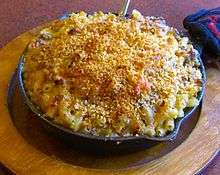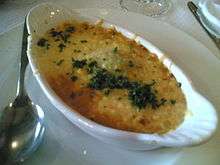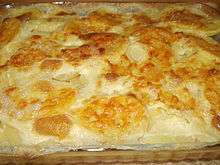Gratin
Gratin (French pronunciation: [ɡʁatɛ̃]) is a culinary technique in which an ingredient is topped with a browned crust, often using breadcrumbs, grated cheese, egg or butter.[1][2][3] Gratin originated in French cuisine and is usually prepared in a shallow dish of some kind. A gratin is baked or cooked under an overhead grill or broiler to form a golden crust on top and is often served in its baking dish.[1]


A gratin dish is a shallow oven-proof container used to prepare gratins and similar dishes.
Terminology
The etymology of gratin is from the French language words gratter, meaning "to scrape" or "to grate" (for example, "scrapings" of bread or cheese), and gratiné, from the transitive verb form of the word for crust or skin.[4] The technique predates the current name which did not appear in English until 1846 (OED, s.v. "gratin").
In addition to the well-known potato dishes such as gratin dauphinois, gratin may be applied to many other bases of meat, fish, vegetables, or pasta.[1][5]
Preparations
Potato-based
Potatoes gratiné

Potatoes gratiné is one of the most common of gratins and is known by various names including "gratin potatoes" and "Gratin de pommes de terre". Slices of boiled potato are put in a buttered fireproof dish, sprinkled with cheese and browned in the oven or under the grill (broiler). They may also be baked under a steamed crust of potatoes.[6] In North America, the dish is referred to variously as scalloped potatoes, funeral potatoes, potatoes au gratin, or au gratin potatoes. (Note that the term scalloped originally referred to a style of seafood dish rather than to one specifically based on the scallop.)[7] In French-speaking Canada, the dish is referred to as patates au gratin. Australians and New Zealanders refer to it as scalloped potatoes or potato bake.
Pommes de terre gratinées
To make pommes de terre gratinées, or "potatoes with cheese", according to the recipe of Marcel Boulestin, large floury potatoes are baked in the oven, then halved and the flesh scooped from the skins. The flesh is then mashed together with butter, cream, grated cheese and seasoning(s). The mix is then scooped back into the skins, arranged in a baking dish, sprinkled with grated cheese and browned in the oven or under the grill. This preparation is also called twice-baked potatoes.[6]
Gratin dauphinois
Gratin Dauphinois is a speciality of the Dauphiné region of France. The dish is typically made with thinly sliced and layered potatoes and cream, cooked in a buttered dish rubbed with garlic.[1] Some recipes add cheese and egg.[8]
Gratin savoyard
Gratin savoyard is a similar dish found in the adjacent Savoie (Savoy) department. It consists of alternating layers of sliced potatoes, Beaufort cheese, and pieces of butter, with bouillon as the liquid.[1][9] Cream is not used.
Other preparations
Pasta
A common alternative to using potatoes in a gratin is the use of various kinds of pasta, such as penne, rigatoni, fusilli / spirelli, or tagliatelle.
Seafood
Sole au gratin is a sole gratin, often is covered with mushrooms. Many fish-based gratins use a white gratin sauce and cheese, and brown quickly.[3] Cozze gratinate is a mussels-based recipe found in Italy.
Vegetable
Gratin Languedocien is made with eggplant and tomato, covered in breadcrumbs and oil, then browned.[3] This dish is similar to the Italian dish known as melanzane alla parmigiana. Other vegetables commonly used in gratin dishes include cauliflower,[10] spinach,[11] and butternut squash.[12]
Janssons frestelse ("Jansson's Temptation") is a Swedish gratin of potatoes, onions, and preserved fish, somewhat similar to a French dish of potatoes with anchovies.[13]
Many gratinéed dishes are topped with béchamel, mornay or other sauces.[14]
See also
References
- Courtine, Robert J. (ed.) (2003) The Concise Larousse Gastronomique London: Hamlyn ISBN 0-600-60863-8
- The American Heritage Dictionary of the English Language, Fourth Edition definition from dictionary.com
- Montagne, Prosper (1961). Larousse Gastronomique. USA: Crown Publishers. pp. 1101.
- Gratin from epicurious.com's Food Dictionary
- Le Répertoire de La Cuisine by Louis Saulnier, 17th Edition, published 1982
- Elvia Firuski; Maurice Firuski (eds.) (1952) The Best of Boulestin. London: William Heinemann. p. 249.
- Rombauer, Irma S. and Marion Rombauer Becker (1931 [1964]) The Joy of Cooking, p 369. Indianapolis: Bobbs-Merrill. ISBN 0-452-25665-8.
- Elizabeth David (1964 [1960]) French Provincial Cooking. Harmondsworth: Penguin Books. pp. 251–2.
- Larousse Gastronomique (2001)
- Garten, Ina (2004). "Cauliflower Gratin Recipe". Barefoot Contessa. Food Network. Retrieved 2009-02-16.
- Garten, Ina (2001). "Spinach Gratin Recipe". Barefoot Contessa Parties!. Food Network. Retrieved 2009-02-16.
- Stevens, Molly (November 2007). "Spinach Gratin Recipe". Bon Appétit. Bon Appétit. Retrieved 2009-02-16.
- Julia Child, Mastering the Art of French Cooking I, 1961:154f "Gratin de pommes de terre aux anchois"
- Julia Child, Mastering the Art of French Cooking (1961)